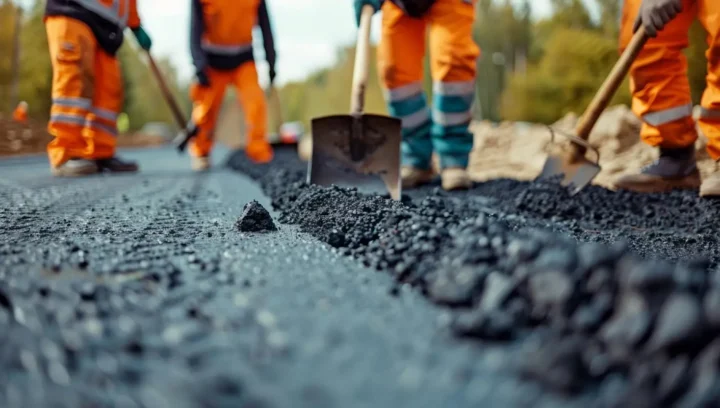Sealcoating vs. Repaving: The Best Option for Your Business
Many marketing strategies aimed at reducing customer churn in businesses focus on strengthening customer relationships, increasing engagement, and delivering consistent value. However, nobody gets excited about a parking lot. But a well-maintained parking lot with a good layout can increase your business’s foot traffic.
A faded or pothole-riddled parking lot speaks of neglect, while a freshly paved or properly sealed one conveys professionalism, not to forget safety (ADA compliance) and higher property value.
When the pavement starts to crack or fade, the dreary question and decision that many property owners face is whether to sealcoat or repave. Let’s take a close look at the differences between sealcoating and repaving to decide which is the best option for you.

Sealcoating vs. Repaving: The Differences
Before getting into the differences between sealcoating and repaving, it is essential to understand why these pavement maintenance methods may be necessary. For local businesses, giving your parking lot a facelift goes beyond aesthetics.
It helps you stay compliant with local regulations and ADA rules and make adjustments based on the weather patterns. This way, you also avoid legal liabilities. However, what are these two pavement maintenance options and how do you know which is best for you?
Sealcoating
Sealcoating is a thin, protective liquid layer of asphalt-based emulsion applied over the surface of your existing lot. It helps shield your lot from UV rays, oil spills, water damage, and even harsh weather conditions..
Many businesses choose sealcoating because it is cost-effective, costing an average of $0.50 to $1.50 per square foot. It also has a quick turnaround, with job completion of a standard lot within 24 hours and ready for use within 48 hours.
Sealcoating is best for parking lots with no major structural damage. If you are looking for a low-cost option for your parking lot, sealcoating works best. On that note, retail stores and restaurants, apartment complexes, or small residential properties can benefit from sealcoating.
Repaving
Contrary to sealcoating, repaving is a total overhaul. It involves a complete removal and replacement of the top layer of your asphalt. In cases of severe damage, the existing asphalt may need to be completely demolished and replaced.
If the structural integrity of your parking lot is crumbling, has deep cracks, drainage issues, or too many patches, repaving will help ensure long-term stability. This not only improves traffic flow and layout updates, but it also provides you with a chance to redesign your layout, especially for better ADA compliance and optimized customer flow.
While it is more expensive than sealcoating, costing an average of $3 to $15 per square foot, it is necessary when about 25% to 30% of your pavement surface is damaged. It also takes longer for it to cure, with as long as two weeks for full curing to take place.
However, it is worth the while if your business receives high traffic, which can cause the pavement to wear faster. Shopping centers, large retail outlets, warehouses, and industrial sites where heavy vehicles ply are all businesses that can benefit from repaving.
Quick Comparison Between Sealcoating vs. Repaving
One thing is certain though, ignoring your worn or damaged pavement is a costly mistake. You could get into legal trouble, get fined, or lose customers. Once you see that your pavement is due for maintenance, consult a paving company in San Jose and choose between sealcoating or repaving, depending on the type of business you run and its scope. Here’s a quick rundown of the purpose and differences between sealcoating and repaving:
| Feature | Sealcoating | Repaving |
| Purpose | Protection and aesthetic renewal | Structural overhaul and longevity |
| Average Cost | $0.50 to $1.50 per square foot | $3 to $15 per square foot |
| Downtime | Maximum of 48 hours | Up to 14 days |
| Frequency of Renewal | Two to three years | Every 15 to 20 years |
| Best For | Preventive maintenance | Heavy damage or full redesign |
| Pros | Enhances curb appealCost-effectiveExtends pavement life | Addresses structural damageImproves accessibilityLong-term solution |
| Cons | Does not fix major cracks or potholesWon’t work for a failing lot | More expensiveLonger downtime |
Endnote
A well-maintained parking lot adds to your customer experience, checks off your compliance checklist, and boosts your property value. However, you need to make the right call between sealcoating and repaving based on the needs of your business.
If you are scaling or shifting your business and the current lot no longer serves, choose repaving. It also works great if the lot has deep cracks, is a safety concern, or you want to improve vehicle flow. However, if you merely want to prepare for seasonal traffic, weather changes, prolong the life of your existing asphalt, or improve its dull look on a budget, sealcoating will serve you well.


